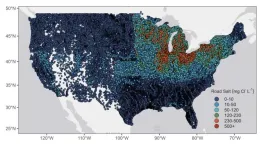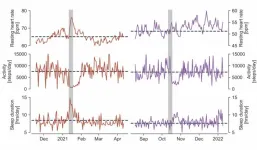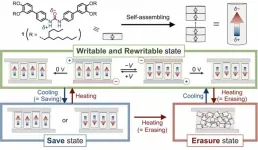(Press-News.org) Since de-icing with road salt began in the 1930s, the salinity of lakes across much of the US has been steadily increasing, posing a potential threat to aquatic life and drinking water supplies. However, a cautiously optimistic new study in Limnology and Oceanography Letters concludes that if we can hold steady or decrease road salt use, levels in many lakes could stabilize below thresholds set by the US Environmental Protection Agency (EPA).
“For the majority of US lakes, road salt pollution could be a solvable problem, if we put our minds to it,” said lead author Chris Solomon, who studies lake ecology at Cary Institute of Ecosystem Studies. However, he cautions that more research is needed to better understand what actually is a safe level of salt in a freshwater ecosystem.
The US applies an estimated 24.5 million tons of road salt on its roads every winter — mostly in the form of sodium chloride. Rain and melting snow carry this salt into local waterways and aquifers, where it can cause freshwater salinization syndrome. Not only is this salt harmful to many organisms, but it can leach toxic metals and radioactive materials from soil and water pipes.
Solomon saw the upward-trending lines of salt concentrations in US lakes and wanted to find out where they were headed. Would road salt levels continue to rise, or would they stabilize? With colleagues, he developed a model to explore controls on road salt concentration in lakes to reveal the concentration at which they might level off.
The model looked at road density in lake watersheds, the amount of road salt applied per road mile, and precipitation. Hydrologic fluxes were taken into account to predict how salt pollution flows into and out of lakes. The model calculated the levels at which road salt would be expected to stabilize if salt application was held at amounts reported in 2010-2015, for all of the 461,000 lakes and reservoirs larger than 2.5 acres in the contiguous US.
For lakes in areas with light to moderate road density, the authors found that holding road salt application rates steady could help lakes stabilize below 230 mg/l of chloride per liter of water, the threshold designated by the EPA to protect aquatic life. Reducing application could yield additional environmental and economic benefits without threatening road safety.
The authors note that more research is needed to determine if the EPA’s 230 mg/l chloride threshold is too high. Solomon explains, “The EPA’s chronic toxicity thresholds for chloride were developed with limited data, and there is growing evidence that negative impacts can occur at concentrations well below 230 mg/l.” Even less is known about how salt mixtures from multiple sources affect aquatic life.
Some places have set much lower chloride guidelines, including 150 mg/L in Michigan and 120 mg/L in Canada. The model predicts that chloride concentrations will eventually exceed the 120 mg/L threshold in more than 9,000 US lakes, even if road density and salt application rates stay at current levels.
Unsurprisingly, lakes with predicted salt concentrations in excess of EPA’s 230 mg/l thresholds were most common in the Northeast and Midwest. Most vulnerable were lakes with high road density and high road salt application in their watersheds. They included some 9-10% of lakes in Illinois and Ohio, as well as a smaller percentage of lakes (<0.1 to 1%) in Indiana, Iowa, Kansas, Michigan, Minnesota, New York, Pennsylvania, and Wisconsin.
Achieving safe salt levels in these lakes will require reductions in salt use. This can be done safely by adopting best management practices and new technologies.
As a test of the model’s accuracy, predictions were compared to measurements taken at Mirror Lake in New Hampshire, a site that has been monitored since 1967 by Cary Institute founder Gene E. Likens. After plugging in the local data, the model predicted maximum and minimum salt levels, and the real-world measurements fell within the predicted range. “This gives us confidence that we're in the right ballpark,” said Solomon.
“We don't think the model is perfect. It's a simple model that's meant as a tool for thinking through the problem,” Solomon says. Among other things, the model ignores salt inputs from natural rock weathering and from human activities like agriculture and industry, and does not consider temporary seasonal spikes in chloride. “We hope others will elaborate on the approach and make better predictions. But in the meantime our results suggest that efforts to control salt application can make a big difference, and may help to prioritize those efforts,” Solomon concludes.
Next steps include comparing the model’s predictions to observed data in other places where salt application and lake chloride levels have been documented for many years, and using the model to explore how other forms of global change — such as land use or climate change — alter both precipitation and the need for road salt application.
Citation
Solomon, C.T., Dugan, H.A., Hintz, W.D., Jones, S.E. (2023). Upper limits for road salt pollution in lakes. Limnology and Oceanography Letters.
Investigators
Christopher T. Solomon - Cary Institute of Ecosystem Studies
Hilary A. Dugan - University of Wisconsin–Madison
William D. Hintz - The University of Toledo
Stuart E. Jones - University of Notre Dame
This research is based on work supported in part by the National Science Foundation.
Cary Institute of Ecosystem Studies is an independent nonprofit center for environmental research. Since 1983, our scientists have been investigating the complex interactions that govern the natural world and the impacts of climate change on these systems. Our findings lead to more effective resource management, policy actions, and environmental literacy. Staff are global experts in the ecology of: cities, disease, forests, and freshwater.
END
Road salt pollution in many US lakes could stabilize at or below thresholds set by the EPA
Lakes have been growing increasingly salty due to road de-icing, but a new analysis suggests with careful action, concentrations may stabilize
2023-07-25
ELSE PRESS RELEASES FROM THIS DATE:
Data from wearable devices shows power of vaccines against SARS-CoV-2
2023-07-25
Data harvested from wearable devices and health apps could be valuable in public health research, according to a study. Vaccines can prevent SARS-CoV-2 infections and, in cases where the virus is able to break through, vaccination lowers the risks of severe disease, hospitalization, ICU admission, and death. Marc Wiedermann and colleagues used data from smartwatches and fitness trackers collected by the Corona Data Donation Project to investigate whether vaccination produces measurable changes in personal health and wellbeing. The Corona-Datenspende-App was launched ...
Spraying just 12% of the room kills 85% of the mosquitoes
2023-07-25
A study in a semi-natural setting finds that targeting just the very bottom of a room’s walls with insecticide will kill most of the mosquitoes, suggesting a cheaper and easier way to treat houses during disease outbreaks. The mosquito Aedes aegypti is a vector for serious diseases, including dengue, chikungunya and Zika. In Asia and Latin America, one approach taken to control mosquitoes that rest inside homes is indoor residual spraying, in which interior walls are coated with a persistent insecticide. However, the large surface area that must be coated makes the approach expensive to implement. Luca Facchinelli and colleagues sought to identify ...
Deep Longevity and House of Gaia announce strategic partnership to advance longevity research and wellness solutions
2023-07-25
Deep Longevity is at the forefront of AI-based longevity science, using deep learning techniques to analyse multiple data types and develop accurate aging clocks. These clocks provide valuable insights into an individual's biological age, offering a holistic understanding of their health and longevity potential. By partnering with House of Gaia, Deep Longevity seeks to bring their cutting- edge technologies and expertise to a wider audience, empowering individuals to take control of their well-being.
House of Gaia is a respected name in the wellness industry, known for its comprehensive range of holistic health services and programs. By ...
SwRI developing advanced electronic warfare system for U.S. Air Force
2023-07-25
SAN ANTONIO — July 25, 2023 —The U.S. Air Force awarded Southwest Research Institute a $4.8 million contract to further develop an adaptable, “continuously staring,” next-generation electronic warfare system capable of detecting advanced enemy radar signals. Using cutting-edge algorithms in a congested signal test environment, the system demonstrated more than 99% probability of intercepting signals with no false detections in a USAF verified simulated environment, a software model loaded with enemy radar.
“Eliminating ...
Food allergy in infancy linked to childhood asthma and reduced lung function
2023-07-25
Having a food allergy as a baby is linked to asthma and reduced lung function later in childhood, according to a world first study.
The research, led by Murdoch Children’s Research Institute and published in the Lancet Child & Adolescent Health, found that early life food allergy was associated with an increased risk of both asthma and reduced lung growth at six years of age.
Murdoch Children’s Associate Professor Rachel Peters said this was the first study to examine the relationship between challenge-confirmed food allergy in infancy and asthma and poorer lung health ...
New study sheds light on awareness and preferences for bioplastics in Japan
2023-07-25
Non-biodegradable plastics are major contributors to land and marine pollution, destroying habitats and causing harm to both flora and fauna. Hence, the switch to bioplastics is imperative to ensure sustainability. The success of environmental initiatives aimed at increasing bioplastic adoption critically hinges on understanding consumer behavior. However, consumer preferences and perceptions around bioplastics, particularly in Japan and other Asian countries, are not well understood.
A recent study published online on July 10, 2023 in the Journal of Cleaner Production attempted to find answers to questions surrounding Japanese consumers’ preferences ...
A nano switchable polar column system that allows high-density data storage
2023-07-25
In today’s world of digital information, an enormous amount of data is exchanged and stored on a daily basis. In the 1980s, IBM unveiled the first hard drive—which was the size of a refrigerator—that could store 1 GB of data, but now we have memory devices that have a thousand-fold greater data-storage capacity and can easily fit in the palm of our hand. If the current pace of increase in digital information is any indication, we require yet newer data recording systems that are lighter, have low environmental impact, and, most importantly, have higher data storage density.
Recently, a new class of materials called axially ...
New image reveals secrets of planet birth
2023-07-25
A spectacular new image released today by the European Southern Observatory gives us clues about how planets as massive as Jupiter could form. Using ESO’s Very Large Telescope (VLT) and the Atacama Large Millimeter/submillimeter Array (ALMA), researchers have detected large dusty clumps, close to a young star, that could collapse to create giant planets.
“This discovery is truly captivating as it marks the very first detection of clumps around a young star that have the potential to give rise to giant planets,” says Alice Zurlo, a researcher at the Universidad Diego Portales, Chile, involved ...
UBC researchers recover vital resources from wastewater sludge
2023-07-25
If you were ever to see sewage sludge up close, you might be hard-pressed to find any redeemable value; however, researchers at UBC’s Bioreactor Technology Group see it another way.
Using a combination of heat, water and phase separation, UBC researchers have developed a cost-effective method to concentrate phosphorous—which can be efficiently recovered by extraction—from wastewater sludge.
“Phosphorous is a non-renewable, but essential, element for life and has many industrial uses,” explains Huan Liu, a doctoral student with UBCO’s School of Engineering and lead author of a new study investigating ...
A new vision for US health care
2023-07-25
It’s not exactly what he’s best known for, but Alexander Hamilton helped develop the first national, compulsory health insurance policy in the world: a 1798 taxpayer-financed plan Congress approved to cover sick and disabled seamen.
“The interests of humanity are concerned in it,” Hamilton wrote.
And they still are, as MIT Professor Amy Finkelstein notes in a new book. The U.S. has repeatedly tried to provide medical care for those who need it and cannot afford it. These efforts may have started with Hamilton, but ...
LAST 30 PRESS RELEASES:
Injectable breast ‘implant’ offers alternative to traditional surgeries
Neuroscientists devise formulas to measure multilingualism
New prostate cancer trial seeks to reduce toxicity without sacrificing efficacy
Geometry shapes life
A CRISPR screen reveals many previously unrecognized genes required for brain development and a new neurodevelopmental disorder
Hot flush treatment has anti-breast cancer activity, study finds
Securing AI systems against growing cybersecurity threats
Longest observation of an active solar region
Why nail-biting, procrastination and other self-sabotaging behaviors are rooted in survival instincts
Regional variations in mechanical properties of porcine leptomeninges
Artificial empathy in therapy and healthcare: advancements in interpersonal interaction technologies
Why some brains switch gears more efficiently than others
UVA’s Jundong Li wins ICDM’S 2025 Tao Li Award for data mining, machine learning
UVA’s low-power, high-performance computer power player Mircea Stan earns National Academy of Inventors fellowship
Not playing by the rules: USU researcher explores filamentous algae dynamics in rivers
Do our body clocks influence our risk of dementia?
Anthropologists offer new evidence of bipedalism in long-debated fossil discovery
Safer receipt paper from wood
Dosage-sensitive genes suggest no whole-genome duplications in ancestral angiosperm
First ancient human herpesvirus genomes document their deep history with humans
Why Some Bacteria Survive Antibiotics and How to Stop Them - New study reveals that bacteria can survive antibiotic treatment through two fundamentally different “shutdown modes”
UCLA study links scar healing to dangerous placenta condition
CHANGE-seq-BE finds off-target changes in the genome from base editors
The Journal of Nuclear Medicine Ahead-of-Print Tip Sheet: January 2, 2026
Delayed or absent first dose of measles, mumps, and rubella vaccination
Trends in US preterm birth rates by household income and race and ethnicity
Study identifies potential biomarker linked to progression and brain inflammation in multiple sclerosis
Many mothers in Norway do not show up for postnatal check-ups
Researchers want to find out why quick clay is so unstable
Superradiant spins show teamwork at the quantum scale
[Press-News.org] Road salt pollution in many US lakes could stabilize at or below thresholds set by the EPALakes have been growing increasingly salty due to road de-icing, but a new analysis suggests with careful action, concentrations may stabilize







